

Guidelines for submitting articles to San Pedro del Pinatar Today
Hello, and thank you for choosing San Pedro del Pinatar.Today to publicise your organisation’s info or event.
San Pedro del Pinatar Today is a website set up by Murcia Today specifically for residents of the urbanisation in Southwest Murcia, providing news and information on what’s happening in the local area, which is the largest English-speaking expat area in the Region of Murcia.
When submitting text to be included on San Pedro del Pinatar Today, please abide by the following guidelines so we can upload your article as swiftly as possible:
Send an email to editor@spaintodayonline.com or contact@murciatoday.com
Attach the information in a Word Document or Google Doc
Include all relevant points, including:
Who is the organisation running the event?
Where is it happening?
When?
How much does it cost?
Is it necessary to book beforehand, or can people just show up on the day?
…but try not to exceed 300 words
Also attach a photo to illustrate your article, no more than 100kb

The Argarics in Murcia
The Argaric culture was present in Bronze Age Murcia between 2200 and 1550 BC
The Region of Murcia is rich in archaeological sites, this part of Southern Spain attracting a number of 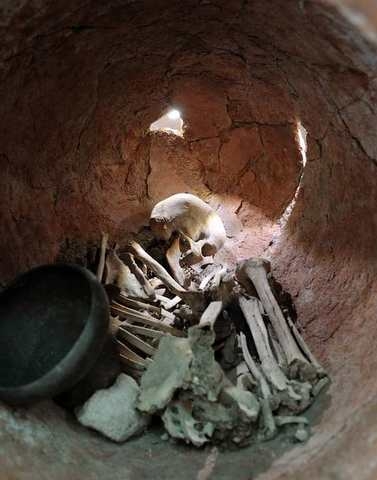 cultures throughout its history, drawn by the abundant natural resources, sea access and the opportunities for settlement and shelter.
cultures throughout its history, drawn by the abundant natural resources, sea access and the opportunities for settlement and shelter.
Between the years of 2200 BC and 1550 BC the Argaric Culture was present in what is now South - eastern Spain, the culture occupying multiple sites in the Region of Murcia, Almería, Granada, Alicante and Jaén. This period falls within what is widely known as the Bronze Age, a stage in technological development which co-incides broadly with other populations developing along the same lines within Europe: Wessex and Armorican Tumuli, ( Hilversum Culture of Central Netherlands, Belgium and Northern France, broadly 2000 BC to 1400 BC) Polada (Italy, 13th and 14th century BC) and Unetice ( 2300-1600BC, based around the Czech republic, western Poland, and Southern and central Germany).
The Bronze Age denoted an era in which mankind had developed metallurgical skills which enabled him to 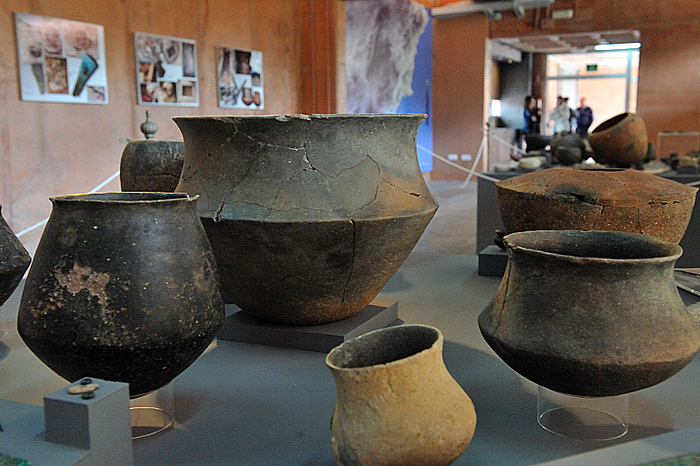 build substantial settlements and change his method of farming from subsistence hunting and gathering to cultivating enough crops to feed a larger, static population. Advances in metallurgical technologies made the agricultural processes of production easier, and individuals were able to develop specialist skills, opening up the way for trade, social development and structure, territorial organisation and definition, emergence of funeral rites and the expansion of the population.
build substantial settlements and change his method of farming from subsistence hunting and gathering to cultivating enough crops to feed a larger, static population. Advances in metallurgical technologies made the agricultural processes of production easier, and individuals were able to develop specialist skills, opening up the way for trade, social development and structure, territorial organisation and definition, emergence of funeral rites and the expansion of the population.
The "discovery" of the Argaric culture is widely accredited to brothers Henry and Louis Siret, Belgian mining engineers who discovered the first burials in the course of their mining work and who subsequently produced the book, " The first ages of metal in the south-east of Spain" which laid down the foundations for subsequent studies and excavations based on their findings. The brothers first excavated the site of El Argar in Almería, as well as studying other sites which showed noticeable uniformity, including that of La Bastida in Murcia.
The distribution of the Argaric society
This society derives its name from the town of El Argar in Almería, which is the location of the most 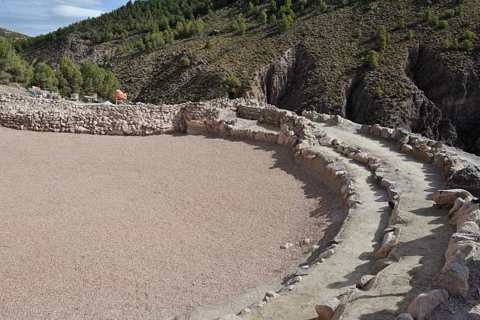 substantial settlement relating to this culture, first excavated by the brothers. There are different theories of where the epicentre of the Argaric culture was, two schools of thought positioning it in what’s commonly referred to as the “Vera depression “ in Almeria or the Guadalentin Valley, centred around the Lorca area, to occupy an area of 33000 square kilometres, throughout the Region of Murcia, Almería, Granada, Alicante and Jaén.
substantial settlement relating to this culture, first excavated by the brothers. There are different theories of where the epicentre of the Argaric culture was, two schools of thought positioning it in what’s commonly referred to as the “Vera depression “ in Almeria or the Guadalentin Valley, centred around the Lorca area, to occupy an area of 33000 square kilometres, throughout the Region of Murcia, Almería, Granada, Alicante and Jaén.
Internally the Argaric world appears to have been divided into territorial definitions and to have been based on a hierarchical structure, excavations demonstrating clear definitions between those who controlled and those who were controlled, as well as a clear indication of conformity and control in the artefacts recovered. Indeed, recent excavations at La Bastida in Totana indicate a slave or socially deprived class, with a 10% upper class, 50% warrior and craftsman class and a 40% slave class distribution of population clearly visible in the manner of interment.
This definition of class is most clearly seen in the distribution and control of metals, the majority of the metallic grave goods belonging to the upper population level. The ownership of metal enabled those bearing weapons to control those without them, and weaponry is only found in the male grave goods of those who clearly had social status.
There is no similarity between the Argaric settlements and other inhabitants of the same area, indicating the Argarics to be a distinct population and the standardisation of artefacts across their communities indicates a rigid level of control and conformity, for example ceramics across all population settlements are virtually identical in their form and follow a standard volume, indicating control of measurement.
The distribution of artefacts indicates clear specialisation and a system of interchange, as some vital elements such as grinding stones for grinding flour and metal ingots for casting tools and weapons have a clear geographical origin. There is also evidence that smaller, outlying settlements would have depended on the larger settlements for the gathering, supply and distribution of goods. The larger centres, however, appear to have drawn in a workforce for specific activity, ie grinding flour and undertaking manual production work, the labouring class who did not necessarily live within the settlement environment.
Argaric Settlements
Argaric settlements are defined by their location.
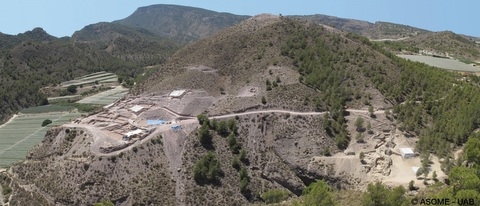 Sites chosen were typically on a hillside, in a naturally defensive position, and near to water resources. In some settlements the proximity of mineral resources appears to have been a primary decision, but as there is evidence in other larger locations of metal being imported into the community in ingot form, proximity to mineral resources was not always a primary requirement.However, defensive capacity was always a key factor.
Sites chosen were typically on a hillside, in a naturally defensive position, and near to water resources. In some settlements the proximity of mineral resources appears to have been a primary decision, but as there is evidence in other larger locations of metal being imported into the community in ingot form, proximity to mineral resources was not always a primary requirement.However, defensive capacity was always a key factor.
The larger settlements have a definably urban layout, densely packed together, with a structure of pathways between them, rectangular dwellings built with stone walls and vegetal roofing. At the La Bastida site visitors can clearly see the construction of the dwellings, complete with raised shelves or benches which would have held ceramic urns full of grain, and walls built using stone, clay and earth supported posts for the wooden framework to hold a roof of wood, branches and leaves, sometimes sealed with clay.
The walls clearly exhibit signs of rebuilding during a period of several hundred years and repairs following the collapse of walls, probably after torrential rains, those at the bottom being occupied by the lower classes who bore the brunt of water run-off..
There is a clear distinction beween buildings occupied by the lower classes at the foot of the settlement and those of the elite, always at the summit. In La Bastida even the stone used is different, the elite using sandstone quarried from nearby for their benches whereas the lower classes used stone gathered from the surface.
El Argar in Almeria ( and El Oficio) and La Bastida in Totana are both major settlements and another large settlement existed in Lorca, although 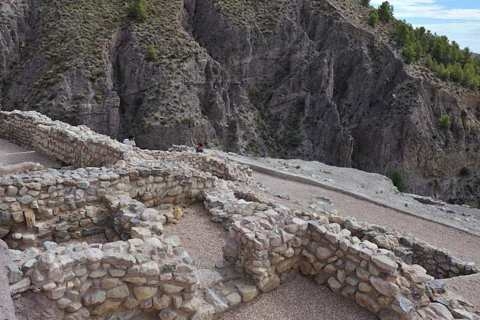 this is buried beneath the existing city so difficult to excavate as a defined area. Further up in Granada, the site of Pinos Puente is also considered to have been an important town. The La Almoloya site in Pliego, north-west Murcia is now being included in the list of substantial settlements.
this is buried beneath the existing city so difficult to excavate as a defined area. Further up in Granada, the site of Pinos Puente is also considered to have been an important town. The La Almoloya site in Pliego, north-west Murcia is now being included in the list of substantial settlements.
El Algar is believed to have covered an area of 16,000 square metres, with a possible population of around 500 ( based on 1000 burials) whilst La Bastida covered 40,000 square metres and could have had 800-1000 inhabitants.
The second type of settlements are definably agricultural. These are usually located on the side of hills, giving some natural defense, and often with evidence of fortifications and smaller populations ( Barranco de la Viuda and Tira del Lienzo in Murcia) and appeared to be small family or village units with a smaller number of houses, such as Cerro de la Viuda (El Hinojar) Cerro de las Viñas ( Coy) and Zapata ( Ramonete).
A third type were isolated agricultural settlements without fortifications: Rincón de Almendricos, Los Cipreses, Los Derramadores (Aguaderas) and la Alcanara (Purias).
However, there does seem to be a relationship between the agricultural settlements and the larger settlements.
There are a couple of examples of coastal settlements such as the Punta de los Gavilanes in Mazarrón and Illeta dels Bnyets which stand apart from the others, but could have been valuable in controlling communications routes, these settlements obviously adopting a more marine dominated existence than the other settlements.
There is clear evidence of interaction and communication between the settlements and la Bastida presents marked evidence of status, with increased evidence of manufacturing, indicating a centre of control and commerce which imported its food stuffs from surrounding settlements rather than agricultural production being the main focus of activity. A point to highlight is that 1500 grinding mills have been found in La Bastida yet not a single agricultural implement, a clear indication that grain was stored and ground in La Bastida, but was not grown there.
There is also clear evidence of military and protective fortifications, with walls and look-out points controlling strategic routes and communications networks between settlements.
And also evidence of civil engineering, the cistern or reservoir in La Bastida which was capable fo holding 300,000 litres being a good example of this.
What did the Argarics eat?
The basic core foodstuff of the Argaric diet was barley, and during the latter period of the culture appears to 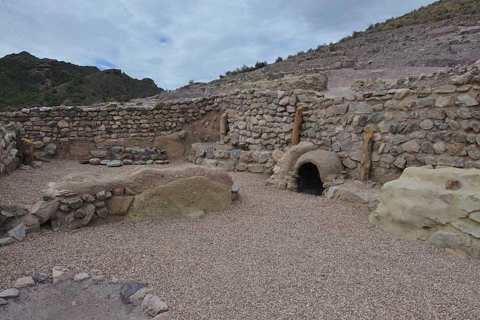 have constituted 90% of the diet. Analysis of seeds found indicates that these crops were mainly grown in dry land situations, and although it was produced in the agricultural areas was transported clean to the larger settlements for storage and distribution. Wheat was also found, but in smaller quantities. Pulses and beans especially broad beans, are also known to have been present, and it is believed likely that these were grown in areas which would have had better access to water and natural simple irrigation, along with flax, again indicating a system which allowed for specialisation.
have constituted 90% of the diet. Analysis of seeds found indicates that these crops were mainly grown in dry land situations, and although it was produced in the agricultural areas was transported clean to the larger settlements for storage and distribution. Wheat was also found, but in smaller quantities. Pulses and beans especially broad beans, are also known to have been present, and it is believed likely that these were grown in areas which would have had better access to water and natural simple irrigation, along with flax, again indicating a system which allowed for specialisation.
It is interesting to note that the distribution of agricultural implements recovered in burials shows that the production and processing of the crops appears to have been done in the agricultural settlements which have a higher proportion of threshing equipment and sickles in the burials, whereas tools relating to the processing and grinding of the cereals are found in much higher proportions in the larger settlements, such as La Bastida and El Argar.
The flour produced by grinding the cereals was used to bake bread and in other basic cooking processes.
Seeds from olives, grapes, figs, berries and linseeds have been found in excavations, but there is no evidence that any of these were cultivated. Meat intake was mainly from livestock, such as sheep and goats, although there is evidence of hunted animals as well. Fishing was a probable activity in the seaside settlements, and remains of nets were discovered at the Punta de los Gavilanes site in Mazarrón.
Evidence of use of horses has been found in some places, such as Cerro de la Encina, but in small quantities.
There is also evidence of widespread use of esparto grass for weaving and manufacturing items such as baskets and ropes.
Argaric Burials.
Burials are one of the most important sources of information about the Argaric culture, providing a wealth of 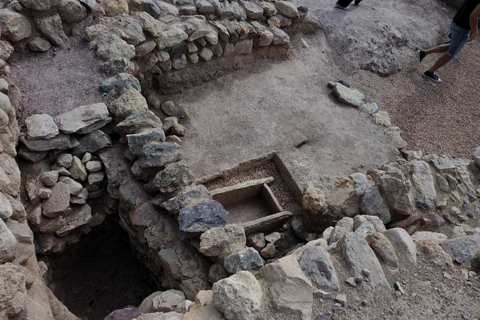 information about the people themselves, their technology, their diet, their health, life expectancy, clothing and ultimately, their decline.
information about the people themselves, their technology, their diet, their health, life expectancy, clothing and ultimately, their decline.
Burial practices are uniform throughout the sites excavated to date, the deceased interred under the floor of the houses in which they lived, in individual graves. occasionally there are multiple graves, but the majority are single.
Generally the corpse was flexioned, ie knees drawn up onto the chest, so that it took up the least space possible, and generally the heads are positioned facing south or west.
There are four main forms of burial: covachas which are cut out of the rock, pits dug into the earth, cists constructed with slabs or masonry and ceramic urns.
The covachas tend to date from 2200BC to 1700BC, cists from 2000-1500BC, pits 2000-1500BC and are more common in the inland areas, and ceramic urns from 1950-1550BC.
Bodies were not cremated, but buried intact, accompanied by grave goods which clearly help to define the social status of the individual.
Pre 1800BC adult male burials of high standing frequently include a log dagger or short sword, a halberd, ceramic vessels and ornaments, whilst women frequently carried a dagger or knife and an awl ( an awl is a long, pointed spike, used for piercing holes in leather or textiles).
From 1800 BC onwards, longer swords start to appear in the male burials, whilst the females have diadems, knives and an awl.
In the second level of the social hierarchy the men frequently had a dagger or axe, the women a dagger/knife and awl, along with ceramic and metal accessories.
As time progresses, there is increased evidence of sophistication in artefact manufacture and a distinct difference in the life expectancy of those in graves with more important grave goods. One of the most important skeletons uncovered at the La Bastida site in Totana shows clear evidence of care, the body that of a woman in her seventies presenting evidence of falls, and broken bones which had mended, as well as multiple childbirths.
Interestingly, the later burials show increased dependence on a more sedentary lifestyle, as evidenced by the increased number of grinding implements and the higher number of artesan manufactured items, but also an increased infant mortality rate, a limited diet and crowded population centres leading to more younger deaths and a lack of mature adults within the population centres.
Argaric Ceramics
Ceramics are one of the most important and frequently recovered elements of Argaric burials.
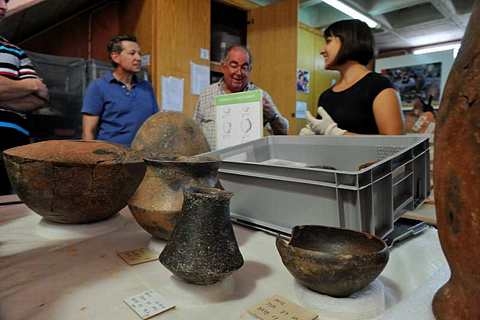 They tend to follow 8 exactly defined forms, common to each community, with simple drinking vessels, storage vessels for liquids, such as honey, or solids, larger vessels for storing grain, cooking vessels and ceramic urns used for burials.
They tend to follow 8 exactly defined forms, common to each community, with simple drinking vessels, storage vessels for liquids, such as honey, or solids, larger vessels for storing grain, cooking vessels and ceramic urns used for burials.
A very interesting comparison of the volumes of the vessels indicates marked uniformity, indicating a standardised form of measurement and a strong element of control within the Argaric society.There is no noticeable development or change in the units used or the standardised forms found throughout Argaric sites.
At this point in time the potters wheel was unknown, so ceramics were fashioned using a coiled system, then smoothed into standard shapes and fired in pits. Analysis has shown that ceramics were fired at around 700 degrees centigrade.
Blackening is common due to the firing method used and smaller pieces often have a polished finish, achieved by rubbing the surface with a piece of cane, or sometimes a smooth stone. Decoration is very infrequent, the majority of pieces lacking embellishment of any sort.
It is interesting to note that finished ceramics are known to have been transported from one area to another, as although ceramics were fired in situ, there is evidence of them being transported from place to place. In La Bastida, for example, some of the ceramic pieces have come from Almería, distinctly identifiable by the composition of the clay used.
There is clear evidence of the values placed on ceramics by the fact that some of the pieces found show evidence of repair, using pins, or staples.
Another important piece of ceramic found in Argaric sites is the ceramic weight manufactured for use in cloth production. These are widespread, and the remains of looms have also been recovered in some sites, as well as a few fragments of linen cloth.
Argaric Tools and household items.
A common item discovered is a hand grinding stone, a vital tool used in the everyday task of grinding cereal 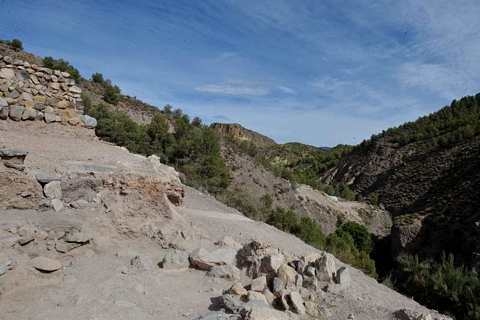 crops. Barley was the main crop, and a small amount of wheat, although barley pre-dominated.
crops. Barley was the main crop, and a small amount of wheat, although barley pre-dominated.
Its likely that the barley was ground using a wooden tool, against the stone surface of the mills.
Other tools found include maces, hammers, moulds for making metal items, anvils, sharpeners, hammer stones, grinding stones. polishing stones, axes and hatchets.
Stone axes were common, particularly in the predominantly agricultural settlements, stone elements inserted into wooden handles, or chipped flint inserted into a wooden structure to make sickles, and threshing boards.
Other objects frequently found related to textile production.
Loom weights, used to hold thread taught, made of clay, usually circular or rectangular, with two to four holes were commonly found in settlements including El Argar, La Bastida, Los Cipreses and Peñalosa.
Spindle whorls with a central hole are also another common item, made from clay, used to tighten the fibers and turn them into yarn via a rotary motion. These have been found in El Argar, Fuente Alamo, Cerro Redondo, Zapata and san Antón.
Bone, ivory and antlers.
Bone, ivory and antlers are also commonly used materials, mainly obtained from domestic animals.
Awls and needles, chisels and smoothers were made using a process of breaking, sawing, and polishing bones from sheep, goats or cattle. used to perforate or join textiles, basketwork or linen. Bone also appears to have been used in scraping hides, and as buttons.
Bone was also used in decorative objects of personal adornment.
Argaric Metallurgy
There is evidence that mining and smelting were undertaken in specific areas where there were rich mineral 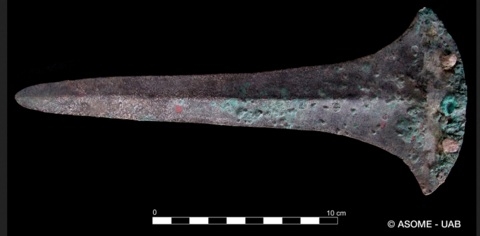 deposits and the material produced as ingots, which were then transported to other areas where it was converted into objects in local workshops.
deposits and the material produced as ingots, which were then transported to other areas where it was converted into objects in local workshops.
The main mining areas were in Almería in Peñalosa, a fortified village which was close to the mining area of Linares - La Carolina.
Considerable evidence exists of smelting in this area, and isotope analysis of completed items recovered in other areas points to this area as the source of the minerals.
Copper was mined in the Sierras of Enmedio, Tercia, Torrecilla, Almenara and Cambrón
Copper ingots would then have been transported to larger towns or settlements such as El Argar and La Bastida at Totana, where these were then cast using moulds or crucibles to form finished articles.
Polishing and grinding would follow the casting process. Metalwork appears to have been carried out in specialist workshops, and not all settlements show evidence of metalwork activity. Larger settlements such as La Bastida at Totana show evidence of specialised workshops: one of the houses excavated at La Bastida is known as the metallurgists house, as it contained tools and fragments of moulds indicating this activity.
What happened to the Argarics?
The questions of where these people came from originally and why their culture disappeared have never yet  been answered. They are believed to have disappeared around 1500BC, a variety of reasons attributed to their decline. There is clear evidence in the burials found that infant mortality was increasingly high in the latter years of the culture and skeletons found show nutritional deficiencies, intensive agriculture of cereal crops ( barley) leaching the soil of nutrients. Lack of variety in their diet also appears to have contributed to nutritional deficiencies.
been answered. They are believed to have disappeared around 1500BC, a variety of reasons attributed to their decline. There is clear evidence in the burials found that infant mortality was increasingly high in the latter years of the culture and skeletons found show nutritional deficiencies, intensive agriculture of cereal crops ( barley) leaching the soil of nutrients. Lack of variety in their diet also appears to have contributed to nutritional deficiencies.
Deforestation made natural resources scarce, leading to a greater dependency on their own farmed products, exacerbating the above, and depletion of other natural resources upon which they depended. Socio-economic changes may also have taken place, but the truth is, archaeologists just don´t know what happened to these populations.
Argaric sites within the Region of Murcia:
In 1991 María Manuela Ayala catalogued 93 different sites in the Region of Murcia, 66 of which are within the 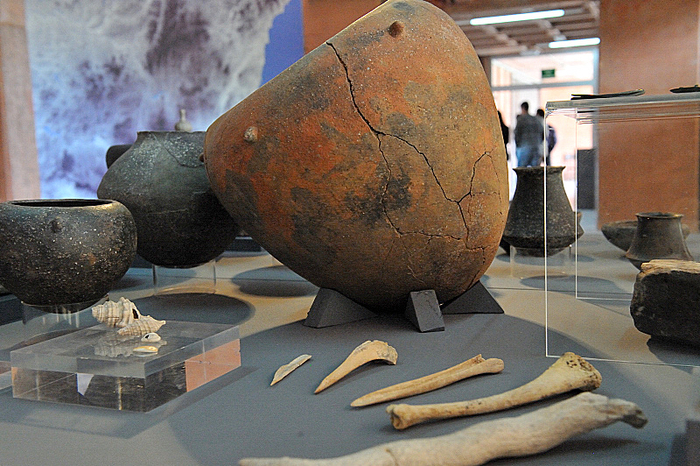 Lorca municipality. Puerto Lumbreras has 12 and the remainder are scattered along the natural communications routes of the rivers .
Lorca municipality. Puerto Lumbreras has 12 and the remainder are scattered along the natural communications routes of the rivers .
Lorca has the greatest density of sites, indeed it has more than than in any other area of Argaric activity.
Some of the names which occur most frequently include La Bastida (Totana)
Monteagudo, (Murcia city), Cabezo Negro (Lorca) , Cabeza Gorda (Totana
Rincón de Almendricos (Lorca) Rincón de Almendricos (Lorca) Puntarrón Chico (Beniaján), Los Molinicos (Moratalla) Loma del Tío Ginés (Puerto Lumbreras), Los Cipreses ( Lorca) Cerro de Murviedro and Cerro del Castillo ( Lorca).
Museums with important collections of Argaric materials in the Murcia Region:
Murcia, Municipal archaeological museum. Sala 7 is dedicated to the Argaric period and has a collection of ceramics, metalwork and funerary burials from across the sites in the region. It also has an interesting recreation of an Argaric dwelling, showing the activities and items which would have constituted daily life. Click Archaeological Museum, Murcia
Lorca municipal archaeological museum. Click Archaeological Museum Lorca
Cehegín, Municipal archaeology museum, Click Municipal archaeology museum, Cehegín
Cartagena municipal archaeological museum, Cartagena Archaeological musuem
Images: Some copyright of Barcelona University and others copyright Murcia Today.
